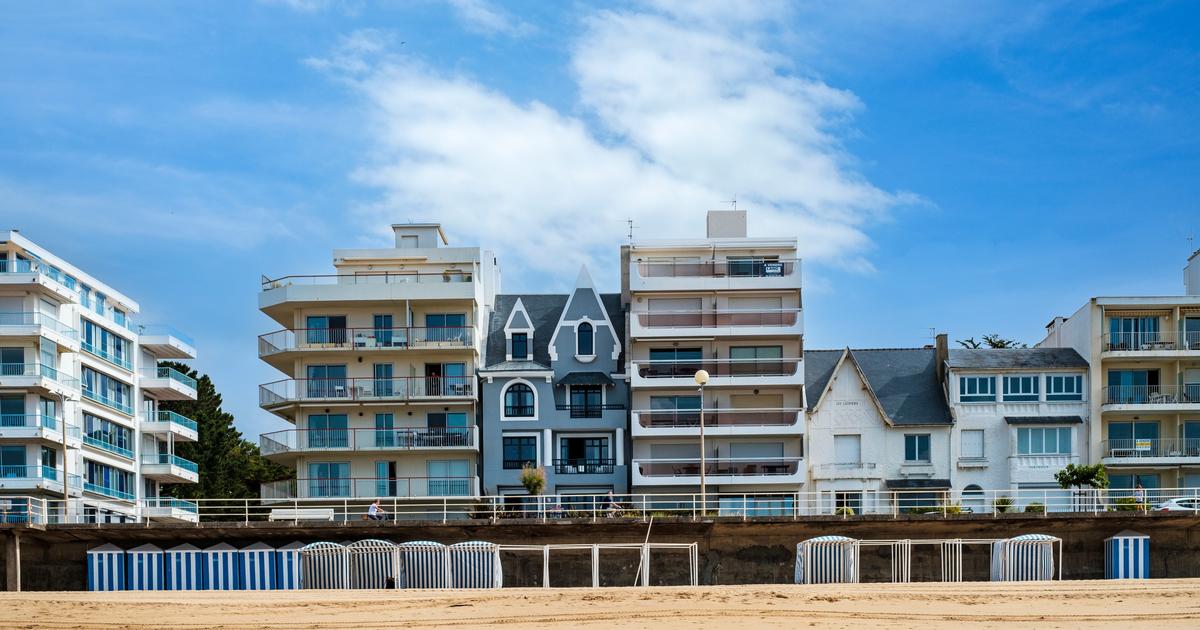The turnaround in the real estate market is coming soon: The prices for houses and apartments will continue to rise rapidly in 2019. According to the "Risk-Reward Ranking 2019" of the real estate service provider Dr. Ing. Lübke & Kelber climbed the prices for condominiums in Germany by an average of 9.4 per cent last year, and new homes by 6.8 per cent.
Especially in major cities such as Berlin, Hamburg or Munich, growth was rapid. How high the prices are in the meantime, can be seen from the following graph: Thus, an average condominium in Munich costs 7436 euros per square meter, with new buildings, it is even 8836 euros.
Also in terms of rents Munich is ahead. For new housing in the Bavarian capital even the first time the limit of 20 euros per square meter was cracked. 20.34 Euro costs there now such an apartment on average per square meter. "At present there is virtually no vacancy in Munich, and the demand for housing can be met almost exclusively via the new building," says the study. It looks similar in Frankfurt, Darmstadt or Münster. "In many cities, the load limits for a large part of the population have been reached in the new construction sector," says Steffen Behrendt. Lübke & Kelber.
For investors, this means that rising rents are no longer to be expected in many major cities - and the ratio of purchase prices to rents has diverged so much that it is difficult to earn more money, especially in the metropolises.
The prospect for prospective buyers is therefore increasingly directed to so-called "B cities", where prices have not risen quite so strongly and can be generated accordingly decent returns.
Dr. Lübke & Kelber has investigated in which of 111 German cities there are still bargains to be made. To do this, the experts used a variety of data from the real estate market to make both a risk and a return assessment for each city and then compared where the actual return expected most outweighs the minimum return given the risk.
The investigation is aimed primarily at real estate investors who want to buy and rent apartments. But even for private individuals who are looking for a property for self-use, the data is interesting.
The result: in cities like Munich , Frankfurt or Stuttgart , the risks of a real estate investment are very low. However, the yields that can be achieved there are now also significantly lower because prices have increased so much.
Cities like Lüneburg, Fürth or Pforzheim , on the other hand, are the winners of the ranking of existing buildings. They offer the best opportunities because the ratio between risk and return is still right. "Especially cities from the second row have become increasingly attractive lately," says Behrendt.
And the winner is: Lüneburg
When it comes to existing real estate, Lüneburg is in first place on the so-called "Hidden Champions" list. Here is the ratio between risk and return still.
2nd place is Fürth . The city has a similarly low risk as the larger neighbor Nuremberg, it offers, according to the study authors but at the same time higher potential and better return prospects.
"Above all, cities from the second row have recently become increasingly attractive due to better growth prospects," says Steffen Behrendt. This includes the city of Pforzheim , which lands in the ranking in third place.
4th place: In addition to Fürth , the Bavarian neighbor Bamberg has made it into the top ten.
5th place goes to Wolfsburg . The industrial city is the headquarters of the car company VW, which drives up the gross domestic product per capita. The unemployment rate is also particularly low.
Flensburg : Here the prices are still relatively moderate.
7th place: Kempten in the Allgäu is also attractive. Here, export-oriented medium-sized companies have settled here.
The market square of Heilbronn : The city has a comparatively low vacancy rate. For existing apartments, she comes in 8th place of the "hidden champions".
Bayreuth is attractive to investors in both new and existing apartments. The city has a particularly low unemployment rate and a high purchasing power per inhabitant.
Place 10 goes to Aschaffenburg . The city has a comparatively low vacancy rate and attracts many commuters.
In the following chart you will find the top 20 of the surveyed cities, sorted by new and existing buildings. The values indicate where the actual expected return most exceeds the minimum return to be achieved in view of the risk.
Cities such as Potsdam or Darmstadt therefore often have a similarly low risk as their larger neighbor cities Berlin and Frankfurt, but at the same time offer higher potential and better yield prospects. "In addition, there is the often higher quality of life in the surrounding area compared to the urban center," says analyst Behrendt. Increasingly, especially young families would migrate to the surrounding area.
However, according to the study, the situation on the real estate markets has eased somewhat compared to the previous year. Thus, unlike last year's survey, there was no city where returns were below the level that the risk was estimated by Drs. Lübke & Kelber would have to achieve at least. Last year, that was still the case in the cities of Düsseldorf, Berlin and Cologne .
What is your city like? In the following table, you can see how much the expected return is above the minimum return. Higher values mean that an investment is worthwhile. Caution is advised at low values.
Find your city: are real estate investments still worthwhile here?
| city | Duration | new buildings |
|---|---|---|
| Aachen | 0.83 | 0.68 |
| Aschaffenburg | 1.83 | 1.42 |
| augsburg | 1.61 | 1.6 |
| Bamberg | 2.09 | 1.98 |
| Bayreuth | 1.83 | 1.12 |
| Bergisch Gladbach | 1.14 | 0.74 |
| Berlin | 0.31 | 0.57 |
| Bielefeld | 1.16 | 0.62 |
| Bonn | 0.9 | 0.94 |
| Brunswick | 1.1 | 1.08 |
| Bremen | 0.74 | 0.74 |
| Darmstadt | 1.6 | 1.22 |
| Dortmund | 0.62 | 0.2 |
| Dresden | 1.68 | 1.95 |
| Dusseldorf | 0.31 | 0.24 |
| Erfurt | 0.46 | 0.9 |
| gain | 1.62 | 1.7 |
| Flensburg | 1.99 | 1.75 |
| Frankfurt am Main | 0.58 | 0.63 |
| Freiburg i. Br. | 1.27 | 1.16 |
| Fulda | 1.61 | 1 |
| Fuerth | 2.11 | 2.05 |
| to water | 1.29 | 1.34 |
| Göttingen | 1.11 | 1.02 |
| Greifswald | 1.75 | 1.14 |
| Guetersloh | 1.14 | 0.89 |
| Hamburg | 0.76 | 0.91 |
| Hanau | 1.55 | 1.46 |
| Hanover | 0.74 | 1.16 |
| Heidelberg | 1.55 | 1.1 |
| Heilbronn | 1.85 | 1.37 |
| Hildesheim | 1.49 | 1.08 |
| Ingolstadt | 1.21 | 1.37 |
| Jena | 0.92 | 1.01 |
| Kaiserslautern | 1.36 | 1.22 |
| Karlsruhe | 1.49 | 1.34 |
| kassel | 0.89 | 1.09 |
| Kempten (Allgäu) | 1.94 | 1.99 |
| keel | 0.85 | 0.78 |
| Koblenz | 1.29 | 1.26 |
| Cologne | 0.59 | 0.35 |
| Constance | 1.63 | 1.28 |
| Landau in the Palatinate | 1.65 | 1.47 |
| Landshut | 1.71 | 1.7 |
| Leipzig | 1.79 | 1.94 |
| Leverkusen | 0.84 | 0.6 |
| Lubeck | 0.95 | 0.63 |
| Ludwigsburg | 1.64 | 1.39 |
| Ludwigshafen on the Rhine | 1.79 | 1.39 |
| Lüneburg | 2.14 | 1.77 |
| Mainz | 1.27 | 1.24 |
| Mannheim | 1.36 | 1.27 |
| Marburg | 1.69 | 1.37 |
| Munich | 0.79 | 0.79 |
| Muenster | 0.85 | 1 |
| Neumünster | 1.72 | 0.69 |
| Neuss | 0.71 | 0.8 |
| Nuremberg | 1.14 | 1.5 |
| Offenbach | 1.39 | 1.23 |
| Oldenburg | 1.76 | 1.38 |
| Osnabrück | 1.6 | 1.33 |
| Paderborn | 0.72 | 0.77 |
| Passau | 1.53 | 1.44 |
| Pforzheim | 2.1 | 1.74 |
| Potsdam | 1.65 | 1.08 |
| regensburg | 1.22 | 1.49 |
| Reutlingen | 1.19 | 1.32 |
| Rosenheim | 1.21 | 1.32 |
| Rostock | 1.21 | 0.86 |
| Stuttgart | 1.02 | 0.86 |
| trier | 1.05 | 0.94 |
| Tübingen | 1.39 | 1.29 |
| Ulm | 1.19 | 1.18 |
| Weimar | 0.78 | 0.83 |
| Wolfsburg | 2 | 1.59 |
| Worms | 1.47 | 1.19 |
| Würzburg | 1.63 | 1.7 |
Distance between return on equity and recommended minimum return (in percentage points) for existing and new buildings in good locations; Source: Dr. med. Lübke & Kelber





/cloudfront-eu-central-1.images.arcpublishing.com/prisa/R5YJ3MNWQRCGTFO4MKHLQKANJI.jpg)


